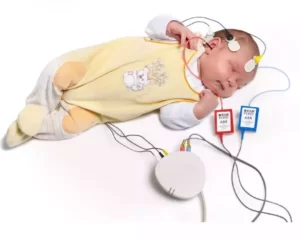Audiology Services -
Auditory Brainstem Response Testing (ABR)
Home | Treatments | Ear, Hearing Loss & Audiology | Auditory Brainstem Response (ABR)
 The Auditory Brainstem Response (ABR) test is also known as the Brainstem Auditory Evoked Response (BAER) Test; evoked auditory potentials; brainstem auditory evoked potentials (BAEP); or evoked response audiometry.
The Auditory Brainstem Response (ABR) test is also known as the Brainstem Auditory Evoked Response (BAER) Test; evoked auditory potentials; brainstem auditory evoked potentials (BAEP); or evoked response audiometry.
This test focuses on changes and responses in brain waves that are stimulated by a clicking sound to evaluate the auditory pathways of the brainstem. This test is mainly performed in infants and children who are unable to cooperate with normal audiometry, in patients who are unable to understand or communicate, or in patients suspected of malingering.
The test is performed by placing the patient in a reclining chair or bed. The patient is asked to relax and remain still. Electrodes are placed on the patient’s scalp, along the vertex and on each earlobe. The patient hears clicking noises or tone bursts through earphones, and the electrodes pick up the brains response and record it on a graph.
There is very little preparation needed for this test. Patients may be asked to wash their hair the night before the test. For infants and children, the physical and psychological preparation that parents can provide for this or any test or procedure depends on the child’s age, interests, previous experience, and level of trust.
There is no discomfort in the administration of this test and there are no risks involved to the patient.
This test is ordered by physicians to help diagnose nervous-system abnormalities, hearing losses (especially in low-birth weight newborns), and to assess neurologic functions.
The auditory brainstem response is found in all people and consists of five individual waves named waves I, II, III, IV, and V. Waves I, III, and V are the most robust of the wave forms. The absolute latencies and interpeak latencies of these waves are measured. In some cases, the amplitude of the individual wave forms are measured. The overall morphology of the wave forms is also evaluated. The auditory brain stem values have a normal range. This varies among patients and instruments used.
Abnormal ABR findings may consist of delays in the absolute latency times of the individual waves, or an increased latency time between waves I-V, or waves I-III, or waves III-V. Poor wave morphology is also considered to be abnormal. Abnormal findings may indicate hearing loss, multiple sclerosis, or a stroke. In rare cases such findings may be suggestive of a benign tumor of the 8th cranial (acoustic) nerve, located in the ear canal or a specific condition called central pontine myelinolysis.
References:
Audiology Services
- Our Audiology Services
- Who is An Audiologist?
- Audiology Tests
- Auditory Brainstem Response Testing (ABR)
- Oto-acoustic Emission Testing (OAE)
- Hearing Aids

